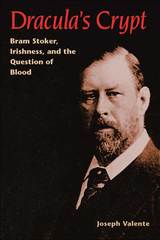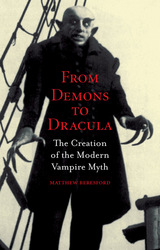2 books about Dracula

Dracula's Crypt
Bram Stoker, Irishness, and the Question of Blood
Joseph Valente
University of Illinois Press, 2001
Dracula's Crypt unearths the Irish roots of Bram Stoker's gothic masterpiece, offering a fresh interpretation of the author's relationship to his novel and to the politics of blood that consumes its characters.
An ingenious reappraisal of a classic text, Dracula's Crypt presents Stoker's novel as a subtly ironic commentary on England's preoccupation with racial purity. Probing psychobiographical, political, and cultural elements of Stoker's background and milieu, Joseph Valente distinguishes Stoker's viewpoint from that of his virulently racist, hypermasculine vampire hunters, showing how the author's dual Anglo-Celtic heritage and uncertain status as an Irish parvenu among London's theatrical elite led him to espouse a progressive racial ideology at odds with the dominant Anglo-Saxon supremacism. In the light of Stoker's experience, the shabby-genteel Count Dracula can be seen as a doppelgänger, an ambiguous figure who is at once the blood-conscious landed aristocrat and the bloodthirsty foreign invader.
Stoker also confronts gender ideals and their implications, exposing the "inner vampire" in men like Jonathan Harker who dominate and absorb the women who become their wives. Ultimately, Valente argues, the novel celebrates a feminine heroism, personified by Mina Harker, that upholds an ethos of social connectivity against the prevailing obsession with blood as a vehicle of identity.
Revealing a profound and heretofore unrecognized ethical and political message, Dracula's Crypt maintains that the real threat delineated in Dracula is not racial degeneration but the destructive force of racialized anxiety itself. Stoker's novel emerges as a powerful critique of the very anxieties it has previously been taken to express: anxieties concerning the decline of the British empire, the deterioration of Anglo-Saxon culture, and the contamination of the Anglo-Saxon race.
An ingenious reappraisal of a classic text, Dracula's Crypt presents Stoker's novel as a subtly ironic commentary on England's preoccupation with racial purity. Probing psychobiographical, political, and cultural elements of Stoker's background and milieu, Joseph Valente distinguishes Stoker's viewpoint from that of his virulently racist, hypermasculine vampire hunters, showing how the author's dual Anglo-Celtic heritage and uncertain status as an Irish parvenu among London's theatrical elite led him to espouse a progressive racial ideology at odds with the dominant Anglo-Saxon supremacism. In the light of Stoker's experience, the shabby-genteel Count Dracula can be seen as a doppelgänger, an ambiguous figure who is at once the blood-conscious landed aristocrat and the bloodthirsty foreign invader.
Stoker also confronts gender ideals and their implications, exposing the "inner vampire" in men like Jonathan Harker who dominate and absorb the women who become their wives. Ultimately, Valente argues, the novel celebrates a feminine heroism, personified by Mina Harker, that upholds an ethos of social connectivity against the prevailing obsession with blood as a vehicle of identity.
Revealing a profound and heretofore unrecognized ethical and political message, Dracula's Crypt maintains that the real threat delineated in Dracula is not racial degeneration but the destructive force of racialized anxiety itself. Stoker's novel emerges as a powerful critique of the very anxieties it has previously been taken to express: anxieties concerning the decline of the British empire, the deterioration of Anglo-Saxon culture, and the contamination of the Anglo-Saxon race.
[more]

From Demons to Dracula
The Creation of the Modern Vampire Myth
Matthew Beresford
Reaktion Books, 2008
In blood-soaked lore handed down the centuries, the vampire is a monster of endless fascination: from Bram Stoker’s Dracula to Buffy the Vampire Slayer, this seductive lover of blood haunts popular culture and inhabits our darkest imaginings. The cultural history of the vampire is a rich and varied tale that is now ably documented in From Demons to Dracula, a compelling study of the vampire myth that reveals why this creature of the undead fascinates us so.
Beresford’s chronicle roams from the mountains of Eastern Europe to the foggy streets of Victorian England to Hollywood, as he investigates the portrayal of the vampire in history, literature, and art. Opening with the original Dracula, Vlad the Impaler, and his status as a national hero in Romania, he endeavors to winnow out truths from the complex legend and folklore. From Demons to Dracula tracks the evolution of the vampire as an icon and supernatural creature, drawing on classical Greek and Roman myths, witch trials and medieval plagues, Gothic literature, and even contemporary works such as Anne Rice’s Interview with a Vampire and Elizabeth Kostova’s The Historian. Beresford also looks at the widespread impact of screen vampires from television shows, classic movies starring Bela Lugosi and Christopher Lee, and more recent films such as Underworld and Blade. Whether as a demon of the underworld or a light-fearing hunter of humans, the vampire has endured through the centuries, the book reveals, as powerfully symbolic figure for human concerns with life, death, and the afterlife.
A wide-ranging and engrossing chronicle, From Demons to Dracula casts this blood-thirsty nightstalker as a remarkably complex and telling totem of our nightmares, real and imagined.
[more]
READERS
Browse our collection.
PUBLISHERS
See BiblioVault's publisher services.
STUDENT SERVICES
Files for college accessibility offices.
UChicago Accessibility Resources
home | accessibility | search | about | contact us
BiblioVault ® 2001 - 2024
The University of Chicago Press









